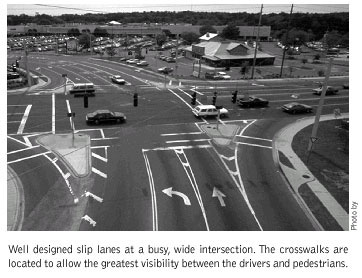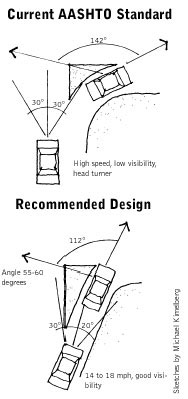15. Well Designed Right–Turn Slip Lanes
Intersections should be designed to accommodate safe pedestrian crossings using tight curb radii, shorter crossing distances, and other tools as described in this document. While right-turn slip lanes are generally a negative facility from the pedestrian perspective due to the emphasis on easy and fast vehicle travel, they can be designed to be less problematic. At many arterial street intersections, pedestrians have difficulty crossing due to right turn movements and wide crossing distances. Well designed right-turn slip lanes provide pedestrian crossing islands within the intersection and a right-turn lane that is designed to optimize the right turning motorist's view of the pedestrian and of vehicles to their left. Pedestrians are able to cross the right-turn lane and wait on the refuge island for their walk signal.
The problem for pedestrians is that many
slip lanes are designed for unimpeded vehicular movement. Islands for
the right-turn slip lanes should be designed instead to discourage high-speed
turns, while accommodating large trucks and buses. The triangular "pork
chop" island that results should have the "tail" pointing
to approaching traffic. Since the traffic signal is timed based on a shorter
crossing, the pedestrian crossing time has much smaller influence on the
timing of the signal. This design has an additional advantage for the
pedestrian; the crosswalk is located in an area where the driver is still
looking ahead. Older designs place the crosswalk too far down, where the
driver is already looking left for a break in the traffic.

Purpose:
- Separate right–turning traffic
- Recommended design can slow turning vehicle speeds and improve safety.
- Recommended design allows drivers to see approaching cross street traffic more clearly.
Considerations:
- Evaluate first whether a slip lane is really necessary.
Estimated Cost:
Approximately $50,000–$200,000 to reconfigure roadway, add striping and construct an island.